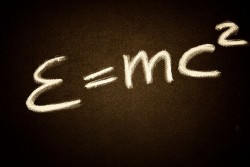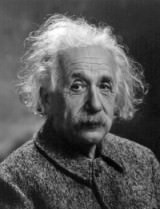As Einstein showed us, light and matter and just aspects of the same thing. Matter is just frozen light. And light is matter on the move. How does one become the other?
Albert Einstein’s most famous equation says that energy and matter are two sides of the same coin.
But what does that really mean? And how are equations famous? I like to believe equations can be famous in the way a work of art, or a philosophy can be famous. People can have awareness of the thing, and yet never have interacted with it. They can understand that it is important, and yet not understand why it’s so significant. Which is a little too bad, as this is really a lovely mind bending idea.
The origin of E=mc2 lies in special relativity. Light has the same speed no matter what frame of reference you are in. No matter where you are, or how fast you’re going. If you were standing still at the side of the road, and observed a car traveling at ¾ light speed, you would see the light from their headlights traveling away from them at ¼ the speed of light.
But the driver of the car would still see that the light moving ahead of them at the speed of light. This is only possible if their time appears to slow down relative to you, and you and the people in the car can no longer agree on how long a second would take to pass.

So the light appears to be moving away from them more slowly, but as they experience things more slowly it all evens out. This also affects their apparent mass. If they step on the gas, they will speed up more slowly than you would expect. It’s as if the car has more mass than you expect. So relativity requires that the faster an object moves, the more mass it appears to have. This means that somehow part of the energy of the car’s motion appears to transform into mass. Hence the origin of Einstein’s equation. How does that happen? We don’t really know. We only know that it does.
The same effect occurs with quantum particles, and not just with light. A neutron, for example, can decay into a proton, electron and anti-neutrino. The mass of these three particles is less than the mass of a neutron, so they each get some energy as well. So energy and matter are really the same thing. Completely interchangeable. And finally, Although energy and mass are related through special relativity, mass and space are related through general relativity. You can define any mass by a distance known as its Schwarzschild radius, which is the radius of a black hole of that mass. So in a way, energy, matter, space and time are all aspects of the same thing.
What do you think? Like E=mc2, what’s the most famous idea you can think of in physics?
And if you like what you see, come check out our Patreon page and find out how you can get these videos early while helping us bring you more great content!


I’m sorry it was a good explanation for understanding special relativity, i.e the idea of the speed of light remaining constant for all frames of reference to the observer, but I still can’t wrap my head around e=mc2 as matter being frozen light and light being matter on the move. I do understand that a car that hits you at 100 miles per hour do more damage than the same car hitting you at 10 miles………uh……ohhhhhhh I see now!
So is Mass and apparent Mass the same thing? If so then the following must be true. F/A=E/C^2 where A is an infinite rate of acceleration. In physics, mass is a property of a physical body which determines the body’s resistance to being accelerated by a force and the strength of its mutual gravitational attraction with other bodies. So if the speed of light is the wall then the mass will be increased because of the inability to accelerate past the speed of light. So if matter is frozen light then Mass is matter in motion. How does the Higgs field give Mass to other particles? It gets them moving with a rate of infinite acceleration. Although the idea that Higgs produces a drag I believe the opposite is true. Space/time is the drag.
if mass were frozen light, then they should forget about all of those particles they are “finding” in the LHC. The famous equation found the potential energy locked in an atom’s nucleus and not what mass is made from. EMR which light is categorized as, is a constant exchange between atomic particles and Aether. In normal conditions, this EMR is just small amounts of radiation that protons always release. When protons are entangled as a nucleus, it is a constant process of absorbtion and emission. This rate of emission is sometimes at an even rate, and sometimes not. When it is not at an even rate, they are either cooled or heated. If heated too much, it is dangerous radiation ex: molten steel in foundries produce high levels of radition. This exchange of EMR is the basic mechanism for energy in our universe.
HERE’S MY WEBPAGE LINK. I LIKE TO REINTERPRET EXPERIMENTAL RESULTS SO WE CAN HAVE MORE USEFUL KNOWLEDGE TO GUIDE US IN PROGRESS
https://www.facebook.com/mikepscience/timeline
Nice article Brian. As a physicist, I like seeing mind expanding articles to encourage young people to think about things they may not have. I would add that relativistic mass, and the inertia resulting therefrom, is quite different from rest mass and inertia resulting from that. They are in fact independent and additive. This is important because the Higgs has been confirmed responsible for rest mass inertia (at least for the particles measured). Also, I think mentioning GR is great and it certainly links space and time to mass and energy. I hope inquisitive folks are encouraged to study physics and really understand the fundamentals of physical reality as supported by multiple experiments and peer review. Thanks again for your article.
Hi Brian,
A very famous idea in physics I can think of is Newton’s 3rd Law of Motion: For every action there is an equal and opposite reaction.
This law leads nicely toward General Relativity.
I think of light as almost mass-less matter (bosonic matter) and fermionic (baryonic / normal) matter as matter with less energy observable compared to radiant (bosonic/light) energy. (ie. its all matter with some properties of light – light being a speed limit matter can only reach theoretically unless you were to go back to T0 of cosmogenisis).
Frozen light is the inverse analogy in the relationship and equally valid (indeed I find it amazing physicists recently slowed a light beam to several Km/s) and also there are negative refractive materials which can do this to light (invisibility cloak anyone?)
Back to Newton’s 3rd law, there is an inverse reaction relationship with both bodies in motion interacting and a sort of inverse inherent to matter/energy in that releasing the potential energy in a body of matter can disperse its mass while increasing the energy output within the space it inhabits (ie nuclear reactions).
The opposite of the nuclear mass/energy reaction could be a black hole or ‘black body’ which in theory can pull-in light to increase the mass of its singularity.
ps. thanks to UT, LC and others here who allowed me to realize some of this as someone not formally trained in the field of science..
I find it amazing and weird that light as ‘massless particles’ can be said to have some properties of matter and that conversely electrons which have properties of energy and fields do have significant mass on the atomic scale.
As Einstein theorized (and was later confirmed experimentally) with the photoelectric effect using a certain substrate, it is possible to convert light to matter/energy by exchanging photons with electrons to convert light into electric current (being itself matter/electrons moving (energy) through another matter substrate (the wire)). A long chain of equal and opposite reactions from the macro scale down to the micro….
This is truly a poor article. M is NOT matter…it is mass. Mass is the
resistance to motion and thus a type of energy. Energy always involves
motion in some form. Matter is an object that that up space so it is
measured in units of space (ie. feet, meters). Do not natter about issues
that you have no basic understanding. Albert was correct in equating
one form of energy with another in relation to the speed of light.
Lastly no experiment proves that photons are massless. Why is a beam
of light bent in a gravitational field? MASS OF A PHOTON.
Can a massless particle be affected by gravity?
Does Einstein’s famous equation explain why some particles (such as electrons) get bogged down in the Higgs field and gain mass but some others don’t?